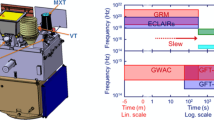Abstract
Work at Goddard is preséntly being carried out in three major areas of gamma-ray burst research: (1) A pair of simultaneously operating 0.8-m2 burst detectors were successfully balloon-borne at locations 800 miles apart on 9 May, 1975, each to atmospheric depths of 3 to 4 g cm−2, for a 20-h period of coincident data coverage. This experiment investigates the size spectrum of bursts in the 10−7 to 10−6 erg cm−2 size region where dozens of events per day are expected on a −1.5 index integral power-law extrapolation. Considerable separation in latitude was used to avoid possible atmospheric and auroral secondary effects. Its results are not yet available. This experiment is the sequel to a single balloon flight in May 1974, in which candidate events were found to fit the −1.5 spectral extrapolation, indicating the need for positive event identification. (2) A deep-space burst detector, the first spacecraft instrument built specifically for gamma-ray burst studies, was recently successfully integrated into the Helios-B space probe. Its use at distances of up to 2 AU will make possible the first high-resolution directional study of gamma-ray burst source locations. Similar modifications to several other space vehicles are also being prepared. (3) Our gamma-ray instrument on the IMP-7 satellite is presently the most sensitive burst detector still operating in orbit. Its results have shown that all measured event-average energy spectra are consistent with being alike. Using this characteristic spectrum to select IMP-7 candidate events of smaller size than those detected using other spacecraft in coincidence, a size spectrum is constructed which fits the −1.5 index power law down to 2.5×10−5 erg cm−2 per event, at an occurrence rate of about once per month.
Similar content being viewed by others
References
Cline, T. L. and Desai, U. D.: 1973, Proceedings of the 13th International Cosmic Ray Conference, Denver,1 (OG), 80.
Cline, T. L., Desai, U. D., Klebesadel, R. W., and Strong, I. B.: 1973,Astrophys. J. Letters 185, L1.
Cline, T. L. and Desai, U. D.: 1974,Astrophys. J. Letters 196, L43.
Klebesadel, R. W., Strong, I. B., and Olson, R. A.: 1973,Astrophys. J. Letters 182, L85.
Metzger, A. E., Parker, R. H., Gilman, D., Peterson, L. E., and Trombka, J. I.: 1974,Astrophys. J. Letters. 194, L19.
Ramaty, R. and Cohen, J.: 1974, Presented at Los Alamos Conference on Transient Cosmic Gamma-and X-ray Sources, 20–31 September, 1973 (Reprint LA-5505-C).
Strong, I. B., Klebesadel, R. W., and Olson, R. A.: 1974,Astrophys. J. Letters 188, L1.
Taylor, B. G.: 1974, Proceedings of the Ninth ESLAB Symposium Frascati, ESROSP 106, 63.
Wheaton, W. A., Ulmer, M. P., Baity, W. A., Datlowe, D. W., Elcan, M. J., Peterson, L. E., Klebesadel, R. W., Strong, I. B., Cline, T. L., and Desai, U. D.: 1973,Astrophys. J. Letters 185, L57.
Author information
Authors and Affiliations
Rights and permissions
About this article
Cite this article
Cline, T.L., Desai, U.D. Advances in gamma-ray burst astronomy. Astrophys Space Sci 42, 17–27 (1976). https://doi.org/10.1007/BF00645519
Received:
Issue Date:
DOI: https://doi.org/10.1007/BF00645519




